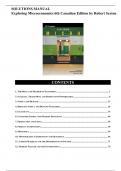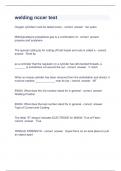SOLUTIONS MANUAL
Exploring Microeconomics 6th Canadian Edition by Robert Sexton
CONTENTS
1. THE ROLE AND METHOD OF ECONOMICS ............................................................................................. 1
2. SCARCITY, TRADE-OFFS, AND PRODUCTION POSSIBILITIES................................................................ 8
3. SUPPLY AND DEMAND ........................................................................................................................... 13
4. BRINGING SUPPLY AND DEMAND TOGETHER ..................................................................................... 26
5. ELASTICITY ............................................................................................................................................ 35
6. CONSUMER CHOICE AND MARKET EFFICIENCY ................................................................................ 40
7. PRODUCTION AND COSTS ...................................................................................................................... 46
8. PERFECT COMPETITION........................................................................................................................ 50
9. MONOPOLY ............................................................................................................................................ 56
10. MONOPOLISTIC COMPETITION AND OLIGOPOLY ............................................................................. 64
11. LABOUR MARKETS AND THE DISTRIBUTION OF INCOME ................................................................. 71
12. MARKET FAILURE AND THE ENVIRONMENT ..................................................................................... 75
, FOR YOUR REVIEW
ANSWER KEY
CHAPTER 1
THE ROLE AND METHOD OF ECONOMICS
Section 1.1 Economics: A Brief Introduction
1. The definition of economics must recognize the central parts of the economist’s point of view:
Resources are scarce, scarcity forces us to make choices, and the cost of any choice is the cost of the
lost opportunity with the highest value.
2. a. Microeconomics
b. Macroeconomics
c. Microeconomics
d. Macroeconomics
e. Microeconomics
Section 1.2 Economic Theory
3. a. The first is positive and the other is normative. The first statement (a positive statement)
expresses a fact or a testable theory that a higher income tax rate would generate increased tax
revenues. The second statement (a normative statement) expresses an opinion regarding how any
additional tax revenues should be used.
b. Both are normative statements that express opinions. The first regards the relative value of
studying physics as opposed to studying sociology, and the second regards the value of studying
either physics or sociology.
c. Both statements are positive. They are expressions of facts or testable theories regarding the
relationship between the price of wheat and how much wheat will be purchased and produced.
d. The first is positive and the other is normative. The first statement (positive) expresses a fact or
testable theory regarding the relationship between the price of butter and how much will be
purchased. The second statement (normative) is an expression of opinion about the social value of
buying butter.
e. Both statements are positive. They are expressions of fact or testable theory regarding
demographic change.
4. a. Positive. The statement is a testable hypothesis.
b. Normative. Asserting that funding for social assistance should be reduced contains a value
judgment about the costs and benefits of doing so.
c. Positive. The statement expresses a fact or a testable theory that tariffs will result in higher prices
for domestic wine.
d. Positive. The statement could be confirmed or refuted by empirical data.
e. Normative. A benefit of charging a provincial sales tax on Internet sales is that it will level the
playing field with non-Internet retailers. However, a cost of this same tax is that it will reduce
1
,Chapter 1
total Internet sales and possibly have other negative effects. The statement implies a value
judgment that the benefits outweigh the costs.
f. Positive. The statement is subject to empirical testing.
5. a. This involves confusing correlation with causation.
b. This involves confusing correlation with causation.
c. This involves the fallacy of composition.
d. This is a violation of the ceteris paribus conditions.
e. There is no fallacy in this statement.
6. Observation and prediction are more difficult in economics than in chemistry because, unlike
chemists, economists generally cannot observe behaviour in a laboratory setting where all relevant
environmental variables can be carefully controlled. Economists study economic behaviour in the real
world, where many variables influence behaviour simultaneously. It is difficult in a complex global
economy to observe and predict relationships between variables, isolated from other effects.
7. Economics is concerned with reaching generalizations about human behaviour. If you generalize on
the basis of observed individual behavior, you risk committing the fallacy of composition.
Generalizations based on observed group behaviour are likely to be both more realistic and useful
(reliable).
Section 1.3 Scarcity
8. Being poor means that you have access to few resources, which limits the goods and services you
consume. Scarcity means you don’t have enough resources to do everything you want to do, so you
have to make choices. Everyone experiences scarcity, because we can always think of more things
that we want than we can produce with our resources.
9. The automobile freed Canadians to travel and helped to create the tourism business. New wants
included motels, resorts, and theme parks. The increased importance of automobile and truck
transportation also created the desire for more and better roads and highways. The automobile also
allowed people to live farther from where they worked, so that people wanted more land and newer
houses.
10. Scarce goods are those that people pay for in either time or money or, in other words, have an
opportunity cost. Garbage and dirty air in the city are not scarce goods since we either pay to get rid
of them or pay with the consequences of their presence. Similarly, salt water is not a scarce good.
Although it is in limited supply, the current abundance of salt water makes it seem limitless. Clothes,
clean air, and public libraries are scarce goods because their production requires the use of scarce
resources that could be used for the production of other goods.
Section 1.4 Opportunity Cost
11. Since Sarah’s time is probably worth more during the school year (it would cost part of her salary),
the opportunity cost of the trip is higher in February than in July.
12. The opportunity cost of this decision valued in dollars would be $33.50 ($30 forgone pay for not
tutoring for two hours + $3.50 for the cup of coffee).
2
, Answer Key
13. a. The opportunity cost of going to college or university includes the income you could have earned
by working instead; it also includes the money spent on school-specific expenses like tuition and
textbooks. Room and board and transportation would not necessarily be included, since you
would need those services even if you were not going to school.
b. The opportunity cost of missing a lecture includes the potential damage to one’s grade in a course
from not being present while important subject material is covered, as well as the knowledge’s
forgone value in the “real world.” The magnitude of the opportunity cost depends partly on how
much essential information the instructor provides during the missed class session or if any
activities were conducted.
c. The opportunity cost of spending $100 today is the $105 you could have spent next year. If you
are withdrawing the money just to have cash in your pocket, the opportunity cost of holding
money is the 5 percent interest you could have been earning.
d. The opportunity cost of snowboarding the weekend before final examinations is the expected
reduction in grades that will result, in addition to the cost of a lift ticket.
14. Inactions are choices not to do something. Inactions, like actions, have consequences. For example, if
you choose not to study, you may fail an exam.
15. One of the most important resources used raising children has historically been the mother's time. As
opportunities for women to hold jobs, start businesses, and participate in political life increase, the
cost of using women's time for raising children increases. As the cost of the mother's time rises, fewer
children are born.
Section 1.5 Marginal Thinking
16. a. $50; $25
b. 3; 5; Mark would go as long as his marginal benefit was greater than the admission price.
c. Yes; 6; Mark would buy the pass because his total benefits exceed his total cost. Once he has the
pass, the marginal cost of attending one more day becomes zero, so he will go as long as his
marginal benefits exceed zero.
17. a. $57; $88
b. 43; 44; he would produce widgets as long as the price (marginal benefit) exceeded the marginal
cost.
18. The expected marginal benefits of jaywalking are the time saved and convenience of crossing the
street where you want. The expected marginal costs are the additional risk of being hit by a car and
the risk of being fined for jaywalking.
a. Increases cost by increasing the risk of being hit by a car.
b. Lowers cost by lowering the risk of being hit by a car and the risk of being fined.
c. Increases the benefit because of the higher value of saved time.
d. Increases cost because of a higher risk of receiving a fine.
e. The time and convenience benefits are larger.
f. The time and convenience benefits are smaller.
19. Marginal thinking involves incremental changes to a plan of action. All of the activities listed involve
marginal thinking. When studying, one chooses whether or not to study for one more hour; when
eating, one chooses whether or not to consume one more portion; when driving, one chooses whether
or not to travel one more kilometre (or one more kilometre per hour); when shopping, one chooses
whether or not to buy one more item or visit one more store; when getting ready for a night out, one
chooses whether or not to spend another minute styling one's hair.
3





